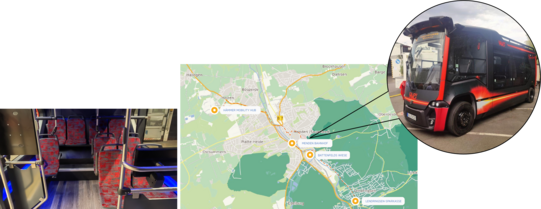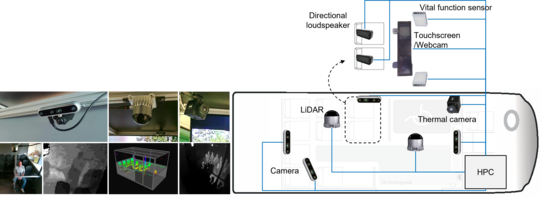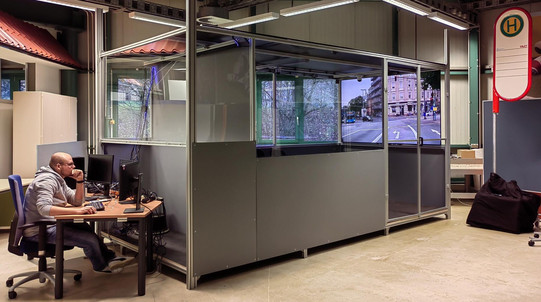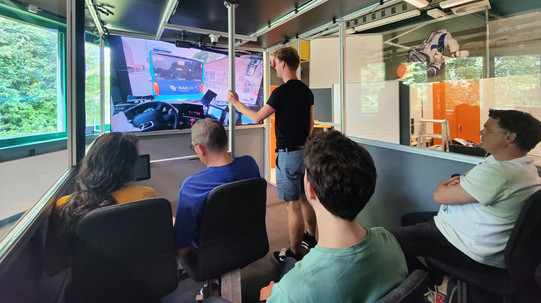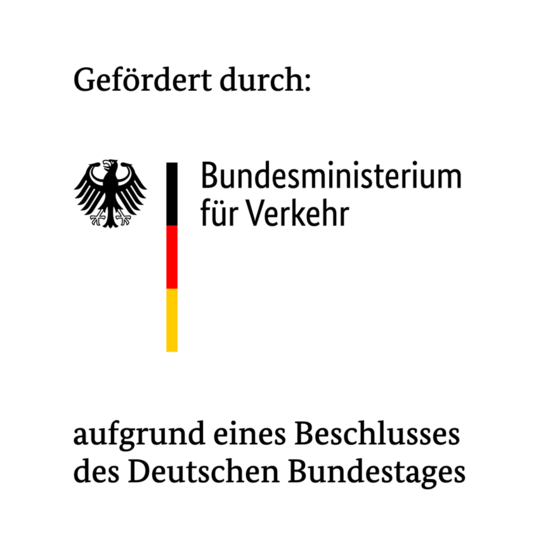The BLiNK project aims to strengthen the climate protection concept in the Hämmer industry region by providing attractive alternatives for company transport. One of the components introduced within this project is an automated e-shuttle as public transport for company mobility. The e-shuttle has been converted by TU Dortmund into a Wizard-of-Oz vehicle and is used to answer acceptance-related questions and for testing in the Hämmer industry region. The objective monitoring of passenger state is carried out using interior sensors such as RGBD, event, and thermal cameras, LiDAR systems, radar-based vital-sign sensors, and microphones. Accordingly, communication with passengers is implemented through designated interfaces such as large front monitors, loudspeakers, and seat units with displays and directional speakers.
Communication with passengers pursues two goals: increasing the perceived safety and improving comfort, both of which together lead to higher acceptance.
- Safety: A safety factor is defined, which is derived from both passenger state and driving situation. The passenger state is determined from data provided by sensors installed in the cabin. In this application, the physical state of passengers is mainly considered, such as their position in the vehicle, whether they are sitting or standing, how they hold on, and their distance from other passengers. The driving situation is recognized based on traffic conditions and the route plan and includes data such as driving dynamics, stopping points or traffic lights ahead, and possible obstacles on the road. Based on these data, a safety factor is calculated for each passenger. If the safety factor for a passenger decreases, they receive individual safety-related information and suggestions for possible measures via the interaction interfaces. The calculation of the safety factor and the application of safety measures are continuously carried out in a control loop until the value rises back to a defined level.
- Comfort: Comfort is also individually defined for each passenger and is assessed based on their state. In this application, the mental state of the passengers is mainly considered. Using the onboard sensors, facial and emotional expressions, social and behavioral signals, as well as the passengers’ need to communicate with the automated vehicle via microphone, are captured and used to estimate comfort. If discomfort is detected in a passenger, the automated system communicates with them via display and loudspeaker to identify the cause and reacts according to the passenger’s response following a predefined protocol. Passenger comfort is continuously monitored, and communication continues until the discomfort is fully resolved.
To also capture subjective passenger satisfaction, they evaluate each ride at the end using a short, illustrated questionnaire. In addition, passengers are surveyed after a certain number of rides and asked to complete questionnaires assessing their acceptance of and trust in the automated shuttle bus.
As a twin of the passenger cabin in the shuttle, a passenger-cabin emulator has also been set up in the laboratory. It is equipped analogously to the shuttle and serves to test and improve the developed algorithms and models. Furthermore, it is useful for analyzing safety-critical situations and repeating identical scenarios.

![[Translate to English:] [Translate to English:]](/storages/rst-etit/_processed_/e/8/csm_Technologie_RST_2018_339_a0a62aaa2f.jpg)
